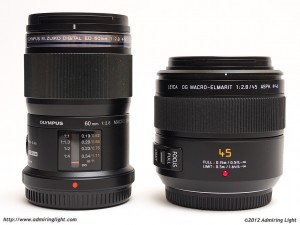
I did a little bit of testing last night with the new Olympus 60mm f/2.8 Macro and I compared it with the only other dedicated macro lens for Micro 4/3, the Panasonic Leica 45mm f/2.8 OIS.
As far as construction goes, they are similarly built. Both have high-grade plastic bodies built to tight tolerances and feel solid in the hand. The 60mm is a bit longer. The 45mm is fatter and a little bit heavier. The 45mm’s focus ring is ribbed rubber, while the 60mm uses ribbed plastic. As far as construction goes, the biggest difference is that the Olympus 60mm is a weathersealed lens, so used on a body like the Olympus OM-D or Panasonic GH3, you’ll get some protection against splashes and dust when shooting in the rain or the desert.
Of course, the Leica has optical image stabilization and the Olympus does not. If using a macro on a Panasonic body or even one of the Olympus Pens, this will provide better stability for handholding than with the 60mm. However, used on the E-M5, both lenses will use the 5-axis IBIS, and are pretty much a wash there. The IBIS of the E-M5 is better than the OIS on the 45mm, so it’s worthwhile to shut off the OIS on this camera. There is a marked difference in price. The Leica 45mm carries a premium price tag of $749, while the new Olympus 60mm comes in at $499.
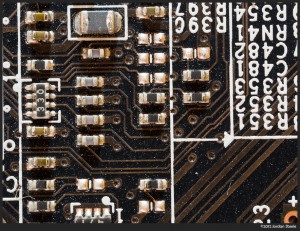
So, last night I decided to test the lenses in a macro setting and at close focus (but not macro) settings. I brought out the motherboard to my previous computer as the test subject. I set the motherboard up vertically and used a tripod to position the camera at the right distance for 1:1 magnification. I manually focused the lenses to 1:1 and adjusted the board and tripod position until the center was dead on using magnified view. Unfortunately, even doing this, it is extremely difficult to get the focus plane 100% flat between two lenses of different focal lengths, as the camera had to be moved between shots. As a result, the corners of the 1:1 shot couldn’t be adequately compared…one corner was slightly better for the Olympus, and the opposite corner superior for the Leica, simply because of the very slight distance in the focal plane.
Above you’ll see the full shot at 1:1 (with the 60mm macro). Framing for both was, of course, identical. Below you’ll see the 100% crops from the two lenses. The 60mm is on the left, and the 45mm on the right.
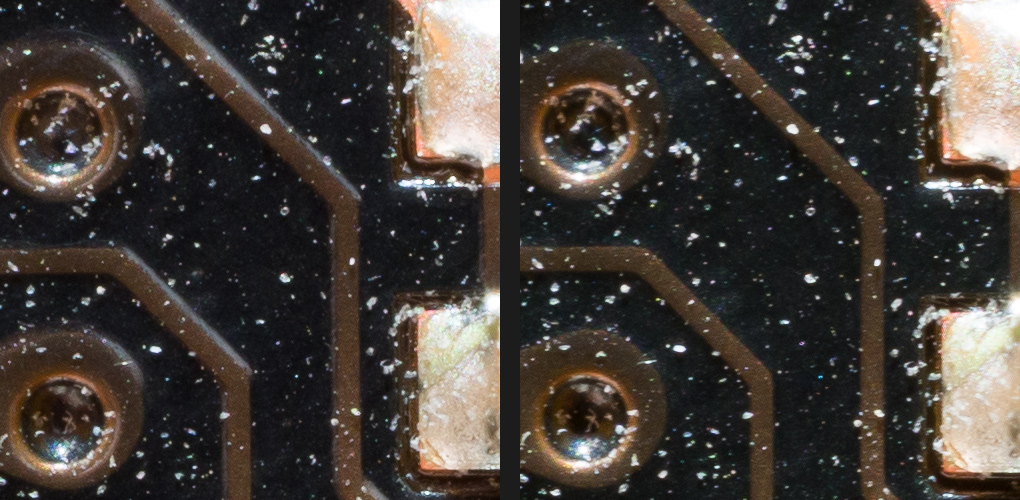
To my eye, the Olympus is ever so slightly sharper, but the differences are close enough that it’s really hard to say for sure that the Olympus is better here.
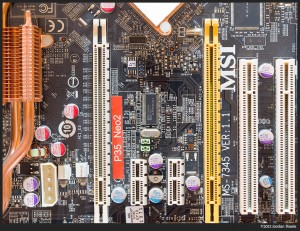
Next I tried a further shot. This was set up at a range where the 60mm macro was focused at about 0.6m. Again, the camera was moved to account for differences in focal length so that the two lenses framed the same scene identically.
Due to the distance being lengthened, it was much easier to position the camera perpendicular to the target and get the whole board in the depth of field of the lenses.
This test was taken using autofocus on the central chip on the motherboard, with both lenses set to f/5.6.
As you’ll see below in the 100% unsharpened crops, the central sharpness is essentially a wash, with both lenses resolving extremely fine detail on the board. Click on the image to see the full size 100% crops.

However, look at the corners, and you’ll see the new Olympus 60mm with an edge in corner resolution.
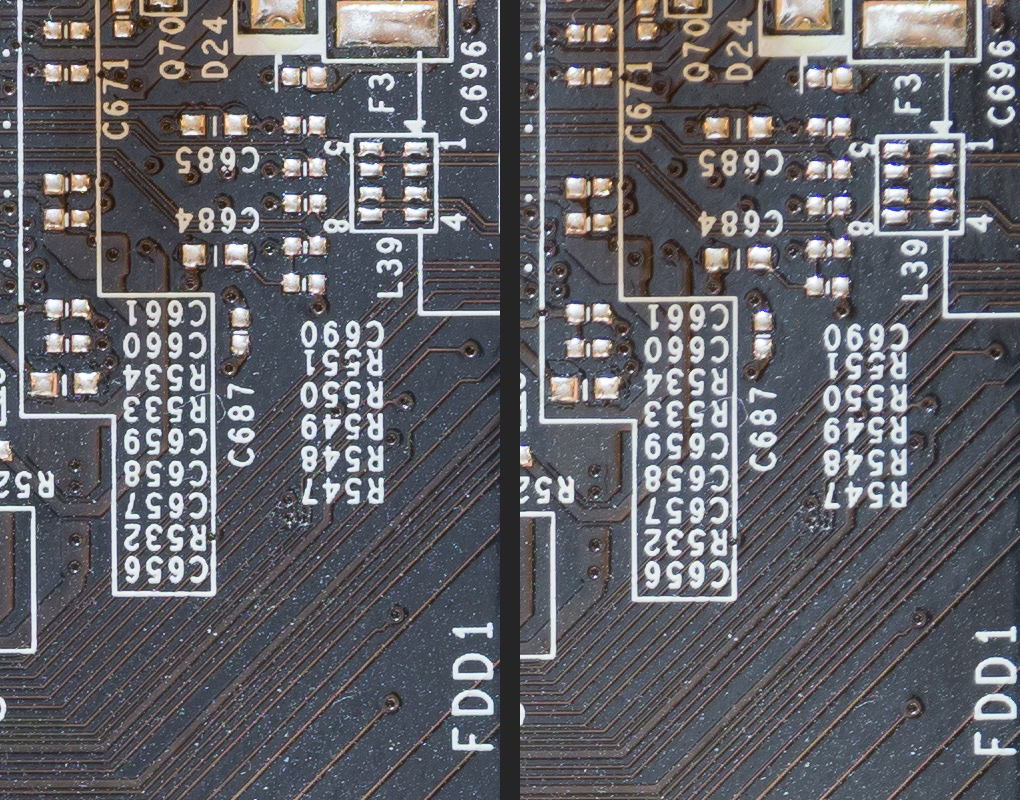
Overall, it’s looking like the Olympus 60mm may have a slight edge in resolution over the also excellent Panasonic Leica 45mm. I’ll be doing a few other tests in the future, concerning portrait use, chromatic aberration and bokeh.

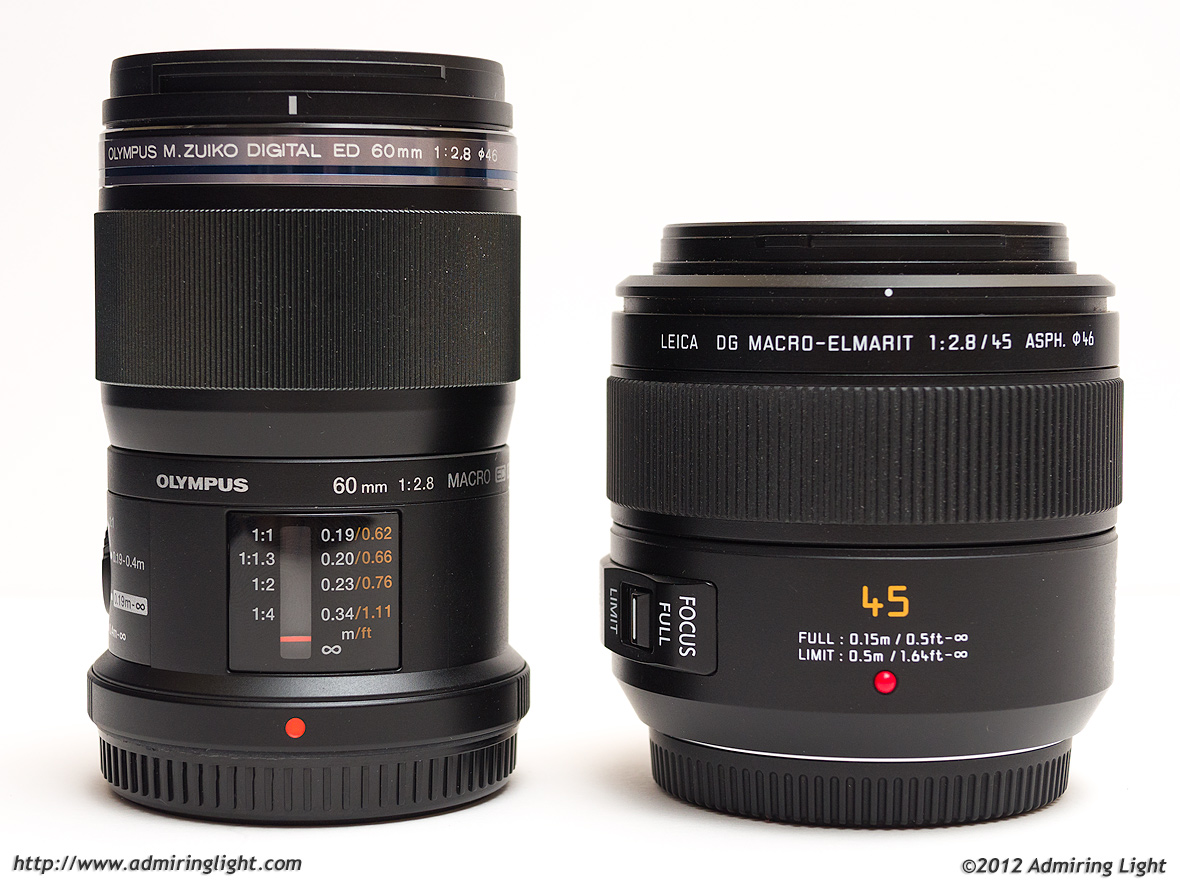
Nice tests!
One question, are you sure that the Panny 1:1 crop is blur free? From what I can see, there is some camera/subject movement. Just look at the dust motes – On the panny image they all seem to be pointing in the same direction while on the olly image they’re all mostly spherical.
While anything is possible, it’s unlikely. I took multiple images and took the best of each. These were tripod mounted on a sturdy tripod and the shutter was released on self time to eliminate shake from the shutter press. IS was off to avoid interference. Also, since these exposures were in the 6 second range, minor movement wouldn’t cause ‘shake’ so much as a double image.
6 seconds? Yeah then motion blur like what I see doesn’t seem possible.
Now I’m wondering if the 45mm lens sample you have is simply defective. I looked again and there really is some kind of streaking. astigmatism caused by a skewed lens element comes to mind…
Do all samples made with the 45mm have this aberration?
As a sidenote, I don’t own either lenses so I’m not biased. 🙂
That said I am quite interesting in getting on of these macro lenses for my GH2. At first I was quite excited about the 60mm for the greater working distance but reading your comparison made me realize that the 45mm has IS, which could prove quite useful for a panasonic MFT like the GH2…
I don’t see what you’re seeing. There is also not a problem with my 45. The size of the dust here is exceptionally small. The large squares on the right of the crop are less than 1mm across. This is extreme magnification.
There is a slim possibility that the focus is just a hair off, but I did zoom to 14x for focus. I may test again to see if I get the same results. Note that in regular use and at pretty much any print size, the 45 is going to look fantastic, even with this being the limit at 1:1. I may try shooting a quarter or something with both lenses.
In testing these (and owning the 45 for about two years), I can say that ultimately, it’s probably going to come down to two things when deciding between these two lenses: Do you want more working distance, or do you need optical IS. For Panasonic owners, it may move towards the IS. For Olympus owners, it’s going to be pretty much dependent on the focal length you want.
I’m about 3 years late with this comment, but yep- I see the same thing as Zoeff.
When i glanced at the pana shot, I instantly thought there was some kind of left/right motion blur.But you say that can’t be the case? weird.
Here’s a gif switching between the 2 shots: https://dl.dropboxusercontent.com/u/692435/60v45.gif
Focus on a dust spec, and you’ll see that it elongates in width (height stays pretty much the same) compared to the olympus.
When I get home I’ll make a quick GIF blink comparison.
I know, sharpness isn’t everything but in this case it creates an impression of blur to me which I find more distracting than uniform ‘fuzziness’. (opposite of sharpness, can’t think of a better word for some reason)
Your findings here are exactly what this shows:
http://www.lensrentals.com/blog/2012/09/quick-look-at-the-olympus-60mm-f2-8-macro
This Olympus 60mm f/2.8 is a gem! I want one!
I’m planning to get the Olympus 60mm macro lens in the next 2 weeks. Any chance you can do a comparo of the 60 macro versus the 12-50mm kit lens in macro mode? I just curious to see how much better the 60 is over the 12-50.
Jordan:
nice review but where did you find a copy of the Oly 60 in the US?
Olympus USA store. I’ve had it for about a month now.
Thanks, this is very well done and useful. I would be interested to know how the Oly kit 12 -50 set to Macro compares. I find the 12 -50 range is useful although I wish the lens was faster. But at 5.6 how would it do in your test?
Why, I’ve done that test: https://admiringlight.com/blog/quick-test-olympus-60mm-macro-vs-olympus-12-50mm-kit-zoom/
You didn’t state this but did you turn the image stabilization off for all these shots?
Leaving IS on when on a tripod will cause blur & it will be slightly different for these 2 since the FL is different.
Thanks for the test. Just want to point out that the Leica is free of longitudinal chromatic aberrations (check out the Photozone review), which means no green/cyan fringes around out-of-focus objects. For me, this is a much bigger benefit than a miniscule difference in sharpness that would never be seen in a print.
Note that the Oly 60/2.8 is also extremely free of chromatic aberration. In fact, it may even be better than the Leica in that regard. Both lenses are very, very good lenses. I think that the 45 is the better choice if you prefer the shorter focal length, or you own Panasonic bodies and need the IS. Otherwise, the Oly is the better buy. it’s slightly better optically (though very close), weathersealed and significantly less expensive.
Lack of stabilization doesn’t make that much difference in macro shooting.
Even small forward-rearward movement moves DOF plane relatively much and that’s something no IS will stabilize so camera/hands need to be well supported anyway.
With ergonomical camera like GH3 it’s rather easy to keep quite stable when you remember supporting hands to something solid instead of shooting with straight arms.
I think Panasonic made their macro also more as general purpose lens while Olympus already had 45mm lens.
In macros/close ups shorter focal length and working distance is hardly advantage but mostly just disadvantage with harder illumination of target for start.
At least GH3’s built in flash works reasonably well with Oly macro for documenting purposes.
Thank you for that test….very helpful.
Thank you for that test….very helpful. Also I’m glad you included Dad among the important things in your life.
Although I have a few macro pics up online on my Facebook and blog, I used both the 45 Leica and the Zeiss Touit on an A7r (old model)…I love your results using the motherboard.
I would buy the new Oly pen just for the hi res stitch.